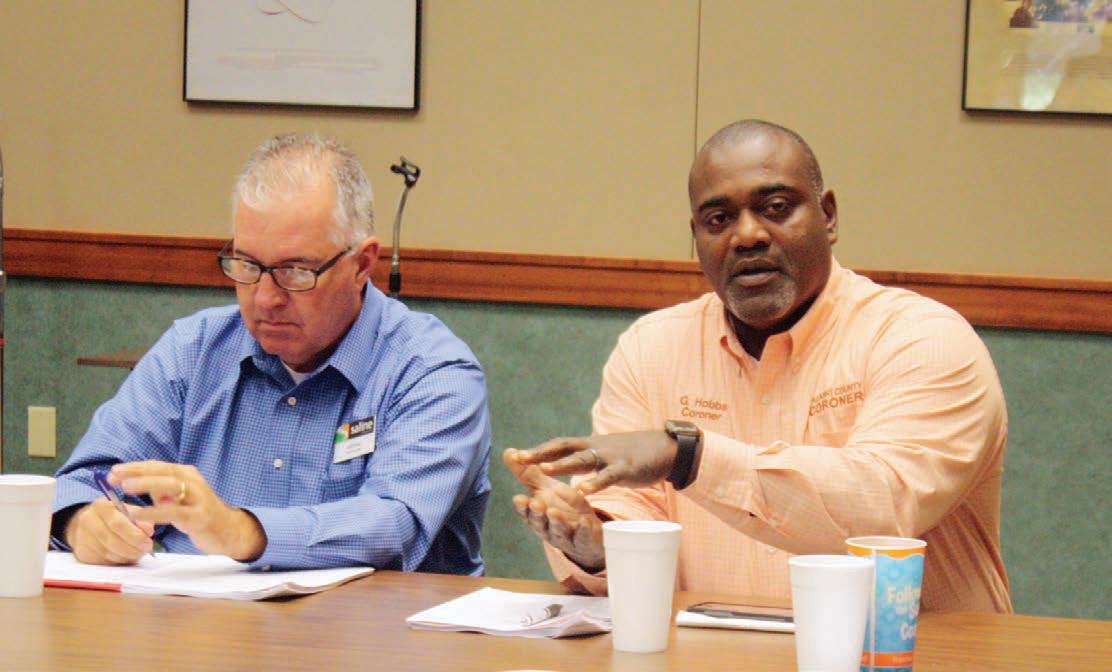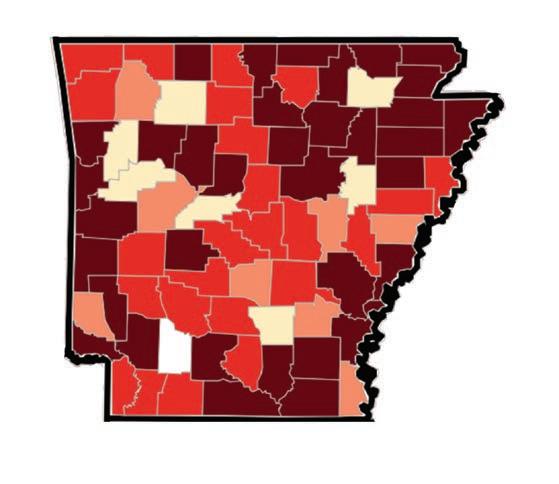
4 minute read
AAC forms Opioid Task Force
Saline County Judge Jeff Arey (left) and Pulaski County Coroner Gerone Hobbs are two of six members of an opioid task force AAC has formed. The task force believes the first steps in combating the opioid epidemic in Arkansas counties is to educate the public about the dangers of opioids and to provide opioid inhibitors such as Naloxone to first responders. In this photo, Hobbs discusses the growing number of drug overdose deaths.
AAC forms Opioid Task Force to combat epidemic
Story by Christy L. Smith Photo by Holland Doran AAC Communications Team
To address the rising incidence of heroin and opioid addiction and fatal overdoses in Arkansas, the Association of Arkansas Counties (AAC) has formed a six-member Opioid Task Force.
The task force is comprised of Pulaski County Coroner Gerone Hobbs, Saline County Judge Jeff Arey, Union County Sheriff Ricky Roberts, Sebastian County Sheriff Bill Hollenbeck, Washington County Circuit Clerk Kyle Sylvester and Craighead County Treasurer Terry McNatt.
“The costs to our society are incredibly high and for counties, the societal impact directly impacts our bottom line in jail costs, clogged courtrooms and extra law enforcement on the streets,” said AAC Executive Director Chris Villines. “We know that if our counties stand together, we can respond to this crisis in an organized, cohesive fashion.”
The task force held its first meeting on Monday, Oct. 9, 2017. Members discussed the opioid epidemic from nationwide, statewide and local perspectives. Specific topics included the success rate of the state’s drug take-back program, the pervasiveness of heroin and fentanyl in Arkansas, scheduled updates to the state’s Prescription Drug Monitoring Program, and local law enforcement’s and first responders’ lack of access to Naloxone, an opiate antagonist that will reverse an opioid overdose and allow a person to breathe during an overdose situation. It gives a first responder time to seek lifesaving medical attention for the victim.
The task force set two initial goals: to create an educational program that will increase the public’s awareness of the dangers of opioids and to help first responders gain access to the training and Naloxone they need to manage an opioid overdose. The task force also voted to support county efforts to puruse litigation against pharmaceutical companies.
“Counties have spent tax payer money — an inordinate amount of money — dealing with the problem that the drug manufacturers have created. They started telling people out there that all of a sudden these opioids are no longer addictive for chronic pain because they are time released. They did not have the data to back that up,” Villines said at a recent meeting
of county assessors.
Opioids are a class of drugs that includes the illegal drug heroin and synthetic opioids such as fentanyl, as well as pain relievers such as oxycodone, hydrocodone, codeine, morphine and others available by prescription, according to the National Institute on Drug Abuse.
A July 26, 2017, Centers for Disease Control (CDC) report showed in 2016 Arkansas had an average opioid prescription rate of 114.6 per 100 people. Arkansas was second only to Alabama, which saw an average of 121 opioid prescriptions per 100 people. See the chart at right for a county-by-county breakdown of prescription rates in Arkansas.
Opioids have proved to be highly addictive, with many users switching to heroin and fentanyl when their supply of prescription pain relievers run out. Opioid addiction affects all ages, genders, and socioeconomic groups.
AAC invited several state and municipal leaders to participate in the Oct. 9 meeting in order to broaden the group’s discussion and focus.
Guests included Arkansas Sheriffs’ Association Executive Director Scott Bradley, Arkansas Department of Emergency Management Director A.J. Gary, Arkansas State Drug Director Kirk Lane, Arkansas Municipal League Executive Director Don Zimmerman, AAC Risk Management Fund Counsel Mike Rainwater, and Arkansas Public Entities Risk Management Association Counsel Ralph Ohm.
State Drug Director Lane said Naloxone and training on how to use it are essential tools for law enforcement officers to combat what he called “the No. 1 drug death threat in the state of Arkansas.”
“[The dangers of opioids] are probably misrepresented because of the acceptance of prescription medication,” Lane said.
After the task force meeting, Lane announced his agency had secured federal grants to provide training and Naloxone to first responders in eight designated counties: Baxter, Crawford, Franklin, Garland, Marion, Scott, Sebastian, and Sharp. He said funding opportunities for other counties may become available in the future.

County Prescribing Rate, 2016
< 57.2
Arkansas Ashley Baxter Benton Boone Bradley Calhoun Carroll Chicot Clark Clay Cleburne Cleveland Columbia Conway Craighead Crawford Crittenden Cross Dallas Desha Drew Faulkner Franklin Fulton Garland Grant Greene Hempstead Hot Spring Howard Independence Izard Jackson Jefferson Johnson Lafayette Lawrence
57.2 - 82.3 National average: 66.5 per 100 people State average: 114.6 per 100 people
82.4 - 112.5
129.1 115.8 142.7 87.8 156.4 116.5 83.6 89.2 77.7 100.9 134.6 115.9 1.1 106.6 131.7 157.3 158.0 108.7 120.3 101.6 143.8 131.8 97.9 22.2 116.7 176.3 77.5 177.8 115.7 105.3 161.6 159.8 104.0 150.4 108.6 127.4 111.2 37.5 Lee Lincoln Little River Logan Lonoke Madison Marion Miller Mississippi Monroe Montgomery Nevada Newton Ouachita Perry Phillips Pike Poinsett Polk Pope Prairie Pulaski Randolph St. Francis Saline Scott Searcy Sebastian Sevier Sharp Stone Union Van Buren Washington White Woodruff Yell
Centers for Disease Control
> 112.5 Missing Data
68.2 67.6 163.5 41.2 101.5 79.3 83.3 109.3 138.6 92.6 93.4 — 0.8 143.4 51.2 159.8 97.6 120.7 117.8 132.6 82.1 105.2 114.2 94.8 97.4 124.7 82.6 169.0 65.5 138.5 152.7 131.5 103.1 98.5 123.5 3.8 66.9










